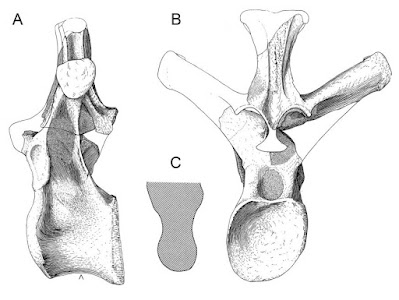ABSTRACT
The northern-most occurrence of Sauropoda in South America was collected in the 1940s from Early–Middle Jurassic-aged continental sediments on the western flank of the Serranía del Perijá in Colombia. Relocation of the site and re-preparation of the specimen, a well-preserved dorsal vertebra, provide important information about the initial diversification of sauropods at low latitudes. The specimen possesses autapomorphies and a unique combination of character states (e.g., divided centropostzygapophyseal lamina, strongly dorsally arched postzygapophyseal facets) that diagnose it as the new genus and species Perijasaurus lapaz. A medium-sized early eusauropod, Perijasaurus inhabited tropical lowland forested areas around the Toarcian–Aalenian boundary. Our phylogenetic analysis recovers Perijasaurus near the base of Eusauropoda, in an unresolved position near Cetiosaurus, Patagosaurus and kin (Bagualia, Spinophorosaurus, Nebulasaurus), and more deeply nested eusauropods. The phylogenetic position of Perijasaurus bolsters the idea that eusauropods achieved a broad geographic distribution during the Early–Middle Jurassic, before the deeper fragmentation of Pangea and after the Toarcian faunal turnover documented at high southern latitudes. Perijasaurus and other basally diverging sauropods display an intermediate level of bone weight reduction in the axial column that represents an antecedent to the more highly developed pneumatic system characterizing Neosauropoda.
SYSTEMATIC PALEONTOLOGY
SAUROPODOMORPHA von Huene, 1932 (Fabbri et al., 2020)
SAUROPODA Marsh, 1878 (Yates, 2006)
EUSAUROPODA Upchurch, 1995
PERIJASAURUS LAPAZ, gen. et sp. nov.
Holotype— UCMP 37689, an anterior to middle dorsal vertebra, possibly corresponding to the fifth element in the series (see below, “Serial Position”).
Etymology— The genus name derives from the Serranía del Perijá, which is a part of the cordillera shared by Colombia and Venezuela (like the La Quinta Formation). The species name refers both to the nearby town of La Paz and the 2016 Acuerdos de Paz (peace agreement) that allowed us to conduct fieldwork in this region.
Pronunciation: pear-EE-hah-SOW-roos la-PAHZ.
Aldo F. Rincón, Daniel A. Raad Pájaro, Harold F. Jiménez Velandia, Martín D. Ezcurra and Jeffrey A. Wilson Mantilla. 2022. A Sauropod from the Lower Jurassic La Quinta formation (Dept. Cesar, Colombia) and the initial Diversification of Eusauropods at low Latitudes. Journal of Vertebrate Paleontology. e2077112. DOI: 10.1080/02724634.2021.2077112
RESUMEN: La ocurrencia más septentrional de Sauropoda en América del Sur se recolectó en la década del 1940 en sedimentos continentales del Jurásico Inferior a Medio, en el flanco occidental de la Serranía del Perijá en Colombia. La relocalización del sitio y una nueva preparación del espécimen, correspondiente a una vértebra dorsal bien conservada, brindan información importante acerca de la diversificación inicial de los saurópodos en paleolatitudes bajas. El espécimen tiene autapomorfías y una combinación única de caracteres morfológicos (por ejemplo, lámina centropostzigoapofiseal dividida, facetas postzigoapofiseales fuertemente arqueadas dorsalmente) que lo diagnostican como un nuevo género y especie, Perijasaurus lapaz. Perijasaurus es un eusaurópodo de tamaño mediano, que habitó en áreas boscosas en tierras bajas tropicales alrededor del límite Toarciano-Aaleniano. Nuestro análisis filogenético muestra a Perijasaurus cerca de la base de Eusauropoda, en una posición ambigua cercana a Cetiosaurus, Patagosaurus y sus parientes (Bagualia, Spinophorosaurus, Nebulasaurus), y eusaurópodos anidados más profundamente. La posición filogenética de Perijasaurus refuerza la idea de que los eusaurópodos alcanzaron una amplia distribución geográfica durante el Jurásico Temprano-Medio, antes de la fragmentación completa de Pangea y posterior al recambio faunístico del Toarciano documentado en las altas latitudes del sur. Perijasaurus y otros miembros basales de saurópodos muestran un nivel intermedio de reducción de la masa ósea en la columna vertebral que representa un precursor del sistema neumático más desarrollado que caracteriza a Neosauropoda.










